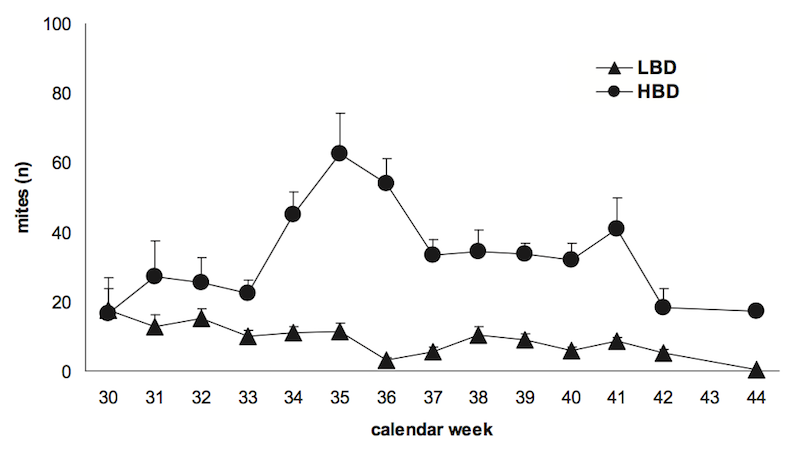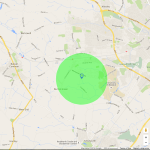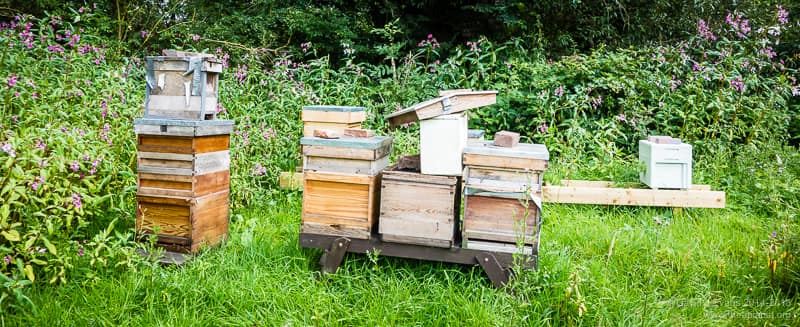Keep your distance
A recent paper by Nolan and Delaplane (Apidologie 10.1007/s13592-016-0443-9) provides further evidence that drifting/robbing between colonies is an important contributor to Varroa transmission. In the study they established multiple pairs of essentially Varroa-free colonies 0, 10 or 100 metres apart and then spiked one of the pair with a known number of Varroa. They then monitored mite build-up in the paired colonies over several months. By comparison of the relative mite increases in colonies separated by different distances they showed that the more closely spaced, the more likely they were to acquire more Varroa, presumably through robbing or drifting.
This isn’t rocket science. However, it’s a nicely-conducted study and emphasises the importance of colony spacing on the transmission of phoretic mites between infested and uninfested colonies – through the normal colony activities such as robbing and drifting – as a primary cause of deformed wing virus (DWV) disease spread in the honey bee population. The paper only studies mite levels, but the association with DWV transmission is well established and unequivocal.
Related studies on the influence of colony/apiary separation
The introduction to the paper provides a good overview of the prior literature on the impact of drifting on disease and Varroa transmission, some of which has already been discussed here. However, some of these studies have not previously been mentioned and deserve an airing, for example:
- Sakofski et al., (1990) showed that there was no difference in mite migration between colonies in closely-spaced rows from those located up to 10m apart.
- Frey and Rosenkranz (2014) showed that high-density colonies (>300 within flight range [2.5 km] of the sentinel colonies) experienced approaching 4-fold greater inbound mite migration than when located in areas containing a low-density of treated colonies. Over a 3.5 month period the difference was 462 +/- 74 vs. 126 +/- 16 mites. This would have a very significant impact if allowed to subsequently replicate in the recipient colonies.
- Frey et al., (2011) previously investigated mite transfer between colonies located 1m to 1500m apart. Strikingly, in this study (which was conducted during a dearth of nectar) mite transmission was effectively distance-independent, with the recipient colonies acquiring 85 – 444 mites over a 2 month period.
What can we conclude from these studies?
- Closely-spaced colonies – for example, the sort of distances used to separate colonies in an apiary – should really be viewed as a single location as far as mite infestation is concerned. A single heavily-infested colony in an apiary will quickly act as a source of mites to all other colonies.
- High densities of beekeepers – assuming the usual range in both the timing and vigour with which Varroa control is practised – is probably detrimental to maintaining low mite levels in your own bees.
- Significant mite transmission occurs over distances of at least 1.5 km … not just between hives in a single apiary. How many colonies are there within 1.5 km of your own apiary? Even if you are careful about controlling mite levels, what about all the beekeepers around you?
- Colonies wth uncontrolled levels of mite infestation, abandoned colonies (or swarms that occupy abandoned hives) and feral colonies located at least 1.5 km away are potential sources from which your carefully-maintained hives get re-infested …
Recent experience with high and low density beekeeping
I’ve moved in the last year from the Midlands to Fife. Beebase and my involvement with local beekeepers suggest that these represent areas of high and low colony-density respectively. For comparison, Beebase indicates that there were over 230 apiaries within 10 km of my home apiary in the Midlands and that there are currently 20 within a similar range in Fife. In the Midlands I was aware of at least 25 colonies (in several different apiaries) within a mile of one of my apiaries. Furthermore, apiaries might contain lots of hives … one of those previously within 10 km of my home apiary was our association apiary which held up to 30 colonies from ~15 beekeepers. In contrast, the closest beekeeper to my current home apiary is almost 3km away … though I acknowledge there may well be hives “under the radar” belonging to beekeepers that are not members of the local association or have not bothered to registered on Beebase (why not?). It’s far too early to be definitive but mite levels in my colonies have been reassuringly low this season. This includes uncapping hundreds of drone pupae – the preferred site for Varroa to replicate – without detecting a single mite. I’d like to think this was due to timely and effective Varroa control, but it is undoubtedly helped because my neighbours are further away … and perhaps better at controlling the mite levels in their own colonies.
This study provides further compelling evidence of the importance of either keeping colonies isolated (which may not be possible) and ensuring that all colonies in the same and adjacent apiaries are coordinately treated during efforts to control mite numbers.



Join the discussion ...